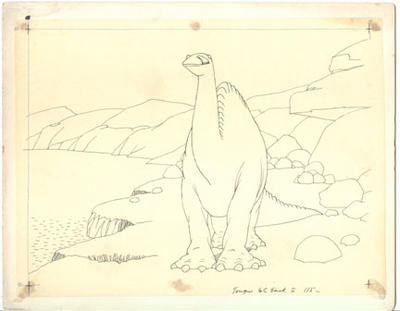The transparent plastic sheets that the crews work with in the film are called cels (for "celluloid"). Like so much else in the history of both animation and comics, the materials actually used to produce the finished products got very little respect. To the creators, they were a means to an end, often considered disposable. Some animation studios scraped the paint off of cels to reuse them; others piled them in big heaps and burned them. In addition, the paints weren't intended to last and often flaked off over time, adding to the scarcity of cels that managed to survive.
.
For a while, the Disney Studios sold cels to tourists at Disneyland for a few bucks each. When I finally figure out how a flux capacitor works and build my time machine, that's one of the first place-times I intend to visit. In the last 20 or 30 years, of course, the value of original animation art has been recognized and, in some cases, inflated beyond reason. Today an early Disney cel in decent condition with a famous character could sell for several tens of thousands of dollars or more.
.
As I wrote about original comic art a while back, original animation art is something I could easily become obsessed with. Too easily. Fortunately I have some self-control, and have so far limited myself to three pieces, ranging from ridiculously modern to almost as ancient as you can get.

This is three-cel set-up from the PowerPuff Girls cartoon. The two girls on the sides (Buttercup and Bubbles) are on one cel, the center girl (Blossom) is on another, and Blossom's mouth is on a third, all stacked atop one another. The mouth gets its own cel so the animators can draw Blossom talking without redrawing the entire figure each time. My girls and I were fans of the PowerPuff Girls, which I thought was occasionally one of the smartest, funniest cartoons around. I bought this as kind of a gift for us all.

Above is a two-cel set-up of Piglet from the 1968 movie "Winnie the Pooh and the Blustery Day," which won an Academy Award for "Best Cartoon Short Subject." Piglet is on one cel and his chair is on another. Since they came without a background, I painted a watercolor landscape to go behind them and printed the lyrics on the painting. I was drawn to this piece for perhaps the most common reason people collect stuff like this: I remembered loving this movie from my childhood and wanted a piece of it. It was Disney. And it was Piglet, who's been a favorite character around our house. I lied and told my family I got it for them; it was really for me.
One of the fun parts of getting an animation cel is watching the movie and freeze-framing it to find exactly where your cel was used. My Piglet actually has little dimples in the pink paint on his arm and foot that I assumed were age-related damage until I saw the exact same dimples on-screen. The flaws are impossible to see blazing past at 24 frames per second, but they were there in the original. I thought that was pretty cool.

I've written about this piece--not really a cel because it was drawn on rice paper before animators began using transparent celluloid--and what it means to me before. This is a frame from "Gertie the Dinosaur" by Winsor McCay done in 1914, many years before Disney made "Steamboat Willie." McCay was a giant in both cartooning and animation, and buying a piece of his work was a long-time ambition of mine and the first thing I did with the "cartooning money" I earned as an advance on Mom's Cancer. When my house catches fire, this is the one thing I plan to grab on my way out the door. After the people and animals are safe. Of course.
That's my entire animation collection. As long as my will is strong and my kids remain in school, that'll be it for a while. I can see how people could go crazy with this hobby, though. Collecting favorite films, themes, artists, owning a unique piece of movie or television history. It's probably just as well I don't have all the money in the world.

4 comments:
A "Powerpuff Girls" fan, eh?
I knew there was a reason I liked you.
-Otis
Thank you, Brian. What a great insight into the history of a technology that most of us are unaware of.
That clip was fun to watch! It makes me realize just how hard it was, and is, to make a really good animated movie! I like how it was such a big hit though, it certainly was the first of its kind! ^^
More about cels please!
Great article.
Your friends at celspotter.blogspot.com
Post a Comment